 Founded in 1971 by Jerry Williams (1937 - 2016) in Columbia, MD, as a maker of reproduction Lionel
and Ives 'O' and Standard gauge trains, originally produced in the 1920's & 1930's. At the outset the
company was called Williams Reproductions Limited. All reproduction trains were made of steel, using the same gauge as the
originals. Items were manufactured in limited runs, and some came in a solid redwood custom made box with special engraving
on the ends and top. Most of the locomotives and cars came in unpainted 'Repli-Kits' or fully painted in colors that
matched the originals. The company also offered restoration parts. Jerry Williams had come from
Classic Model Corp., another Maryland based maker of Standard gauge trains. Around 1975 Williams began
to shift attention to the 'O' gauge post-war era market, first with kits and then with completed models. In the mid to late
1980's, Jerry explored making scale-size locomotives for 3-rail track. In 2007, the company was sold to
Bachmann Industries, where the train line today is known as Williams by Bachmann.
Founded in 1971 by Jerry Williams (1937 - 2016) in Columbia, MD, as a maker of reproduction Lionel
and Ives 'O' and Standard gauge trains, originally produced in the 1920's & 1930's. At the outset the
company was called Williams Reproductions Limited. All reproduction trains were made of steel, using the same gauge as the
originals. Items were manufactured in limited runs, and some came in a solid redwood custom made box with special engraving
on the ends and top. Most of the locomotives and cars came in unpainted 'Repli-Kits' or fully painted in colors that
matched the originals. The company also offered restoration parts. Jerry Williams had come from
Classic Model Corp., another Maryland based maker of Standard gauge trains. Around 1975 Williams began
to shift attention to the 'O' gauge post-war era market, first with kits and then with completed models. In the mid to late
1980's, Jerry explored making scale-size locomotives for 3-rail track. In 2007, the company was sold to
Bachmann Industries, where the train line today is known as Williams by Bachmann.
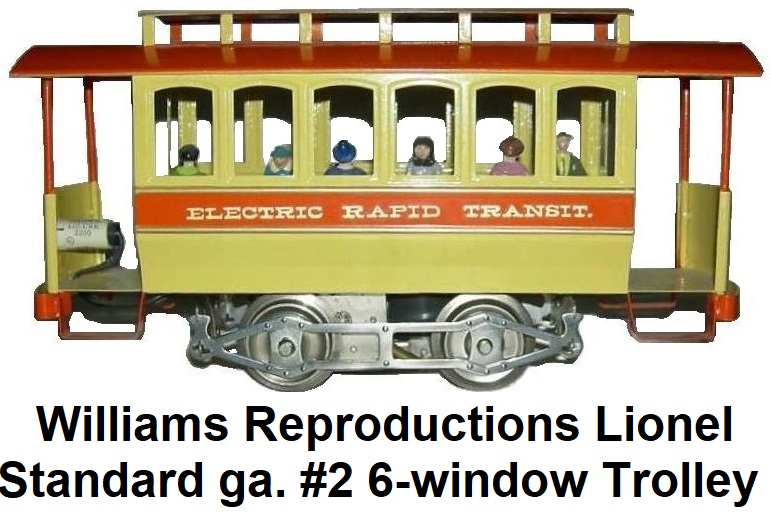 Jerry Williams's interest in electric trains dated back to his boyhood years. In the mid to late 1960's his
interest was renewed and he spent much of his time visiting estate and yard sales to look for collectable Lionel and
Ives trains. He soon recognized that many desirable models were nearly impossible to find in like-new condition, with
most being in need of repair or restoration. Jerry felt that there might be a market for new trains similar to those made
in the pre-World War II years. He first started building and selling toy trains in 1969 in partnership with Fred Mill.
Trading as Classic Models Corp., Fred and Jerry built a quality line of old style Standard gauge tinplate trains of original
design. Jerry felt that prospects would be better if he produced accurate reproductions of the desirable pre-war era trains
instead. Fred preferred to continue to build the Classic Models style of products and the two parted ways. In December of
1971 Jerry Williams established Williams Reproductions Limited as a Maryland Corporation.
Jerry Williams's interest in electric trains dated back to his boyhood years. In the mid to late 1960's his
interest was renewed and he spent much of his time visiting estate and yard sales to look for collectable Lionel and
Ives trains. He soon recognized that many desirable models were nearly impossible to find in like-new condition, with
most being in need of repair or restoration. Jerry felt that there might be a market for new trains similar to those made
in the pre-World War II years. He first started building and selling toy trains in 1969 in partnership with Fred Mill.
Trading as Classic Models Corp., Fred and Jerry built a quality line of old style Standard gauge tinplate trains of original
design. Jerry felt that prospects would be better if he produced accurate reproductions of the desirable pre-war era trains
instead. Fred preferred to continue to build the Classic Models style of products and the two parted ways. In December of
1971 Jerry Williams established Williams Reproductions Limited as a Maryland Corporation.
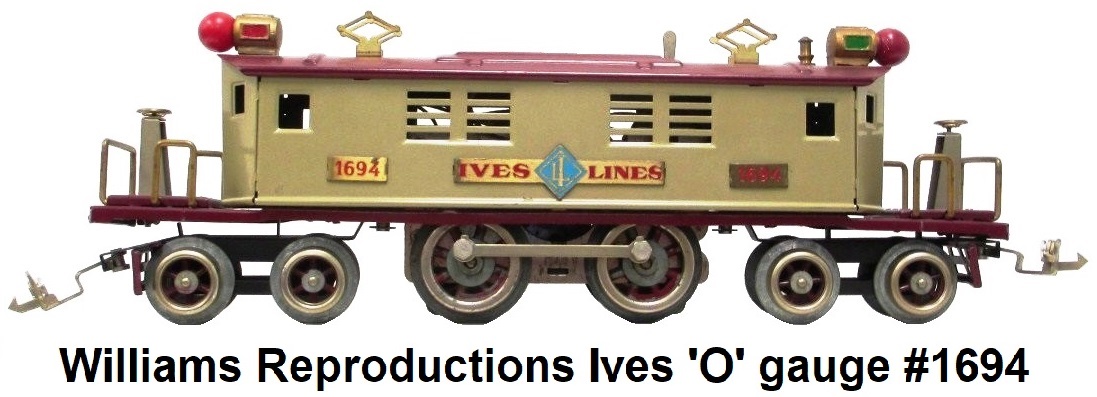 Jerry chose the Ives 'O' gauge #1694 4-4-4 electric locomotive from 1932 as his new company's first project.
This locomotive is one of the rarest 'O' gauge tinplate models ever made, so its rarity and distinctive appearance
established an instant market. Williams began by borrowing a repainted original #1694 to disassemble and duplicate. The
reproduction turned out to be a very close replica of the original. The most conspicuous difference being that the replica
had a separate cab roof, while the original's roof was integral with the cab sides. This alteration made it easier and
economical to facilitate painting the sheet metal parts. The reproduction #1694 was introduced at the TCA's 1972 convention
and was well received. All parts, with the exception of cast headlights, wheels and machine screws, were custom made for
Williams Reproductions from hardened tool steel dies. Because the replica looked so much like the original, TCA officers
asked Jerry to label his product in some way to indicate that it was actually a reproduction. As a result, some of the
Williams Reproductions #1694's are marked with a hand stamped letter 'R' near the center of the underside of the floor, while
others are not. All units were sold with a decorative display track with an appropriately labeled plaque. These models were
not powered, but had dummy motor frames that were ready to accept a motor from a Lionel #262 or similar locomotive. A slot in
the roof was provided to facilitate installation of a hand reverse lever. There were 300 pieces made and sold in the 1972
production run. During later production, a set of matching passenger cars were produced, and these were packaged as sets. The
cars included were the #1695 Pullman, #1696 baggage and #1697 observation.
Jerry chose the Ives 'O' gauge #1694 4-4-4 electric locomotive from 1932 as his new company's first project.
This locomotive is one of the rarest 'O' gauge tinplate models ever made, so its rarity and distinctive appearance
established an instant market. Williams began by borrowing a repainted original #1694 to disassemble and duplicate. The
reproduction turned out to be a very close replica of the original. The most conspicuous difference being that the replica
had a separate cab roof, while the original's roof was integral with the cab sides. This alteration made it easier and
economical to facilitate painting the sheet metal parts. The reproduction #1694 was introduced at the TCA's 1972 convention
and was well received. All parts, with the exception of cast headlights, wheels and machine screws, were custom made for
Williams Reproductions from hardened tool steel dies. Because the replica looked so much like the original, TCA officers
asked Jerry to label his product in some way to indicate that it was actually a reproduction. As a result, some of the
Williams Reproductions #1694's are marked with a hand stamped letter 'R' near the center of the underside of the floor, while
others are not. All units were sold with a decorative display track with an appropriately labeled plaque. These models were
not powered, but had dummy motor frames that were ready to accept a motor from a Lionel #262 or similar locomotive. A slot in
the roof was provided to facilitate installation of a hand reverse lever. There were 300 pieces made and sold in the 1972
production run. During later production, a set of matching passenger cars were produced, and these were packaged as sets. The
cars included were the #1695 Pullman, #1696 baggage and #1697 observation.
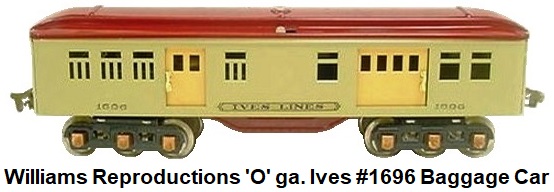
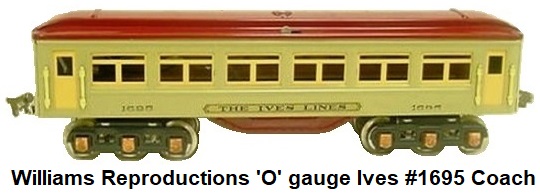
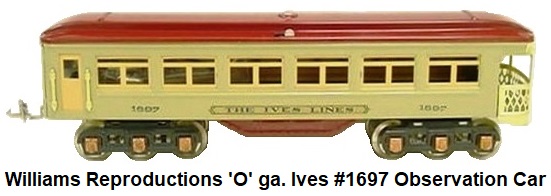
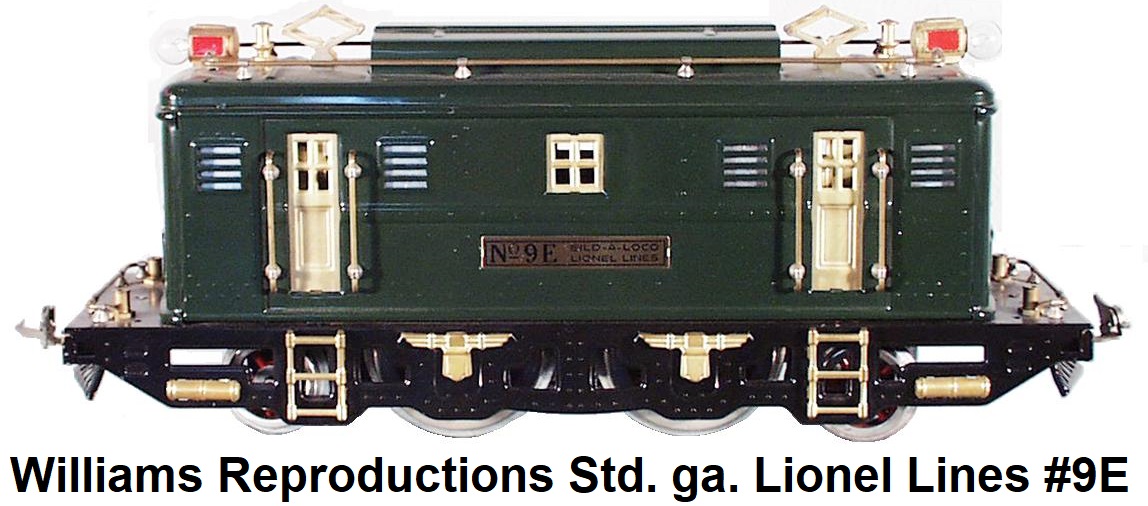 Standard gauge production at Williams Reproductions Limited was called the Golden Memories Series and took
place between the years 1973 to 1983. In 1973 Williams Reproductions Limited released a Lionel #9E electric locomotive.
The original Lionel #9E was not considered to be rare, but it was expensive. The challenge was to create an
excellent reproduction of the #9E at a price which would attract collectors. Original tooling costs estimates were
discouraging but Jerry decided to take the chance and his decision turned out to be a sound one. He again borrowed
a repainted late style #9 and also an early high-roof version and used these originals as the prototypes for modeling.
A few #1694 parts were reused and 16 new tools were made to produce the rest of the parts needed. This too came as a
dummy unit, ready for installation of a 'Bild-A-Loco' or 'Super' motor. There were 300 units made in 2-tone green. When
about half were sold Jerry decided to build high roof versions as well. 200 of these were produced, half of them in orange
and the others in dark green. These were followed by another run of 50 gunmetal-gray units. These were nickel trimmed with
black wheels as opposed to earlier production which was brass trimmed with red painted wheels. The first 300 were sold with
wooden display stands. Another production run of 300 more #9's in multiple colors followed to
satisfy a continuing strong demand. In addition, 100 units were sold in kit form, the first kits issued by Williams.
Because Williams sold their Standard gauge Lionel reproduction locomotives as
Standard gauge production at Williams Reproductions Limited was called the Golden Memories Series and took
place between the years 1973 to 1983. In 1973 Williams Reproductions Limited released a Lionel #9E electric locomotive.
The original Lionel #9E was not considered to be rare, but it was expensive. The challenge was to create an
excellent reproduction of the #9E at a price which would attract collectors. Original tooling costs estimates were
discouraging but Jerry decided to take the chance and his decision turned out to be a sound one. He again borrowed
a repainted late style #9 and also an early high-roof version and used these originals as the prototypes for modeling.
A few #1694 parts were reused and 16 new tools were made to produce the rest of the parts needed. This too came as a
dummy unit, ready for installation of a 'Bild-A-Loco' or 'Super' motor. There were 300 units made in 2-tone green. When
about half were sold Jerry decided to build high roof versions as well. 200 of these were produced, half of them in orange
and the others in dark green. These were followed by another run of 50 gunmetal-gray units. These were nickel trimmed with
black wheels as opposed to earlier production which was brass trimmed with red painted wheels. The first 300 were sold with
wooden display stands. Another production run of 300 more #9's in multiple colors followed to
satisfy a continuing strong demand. In addition, 100 units were sold in kit form, the first kits issued by Williams.
Because Williams sold their Standard gauge Lionel reproduction locomotives as
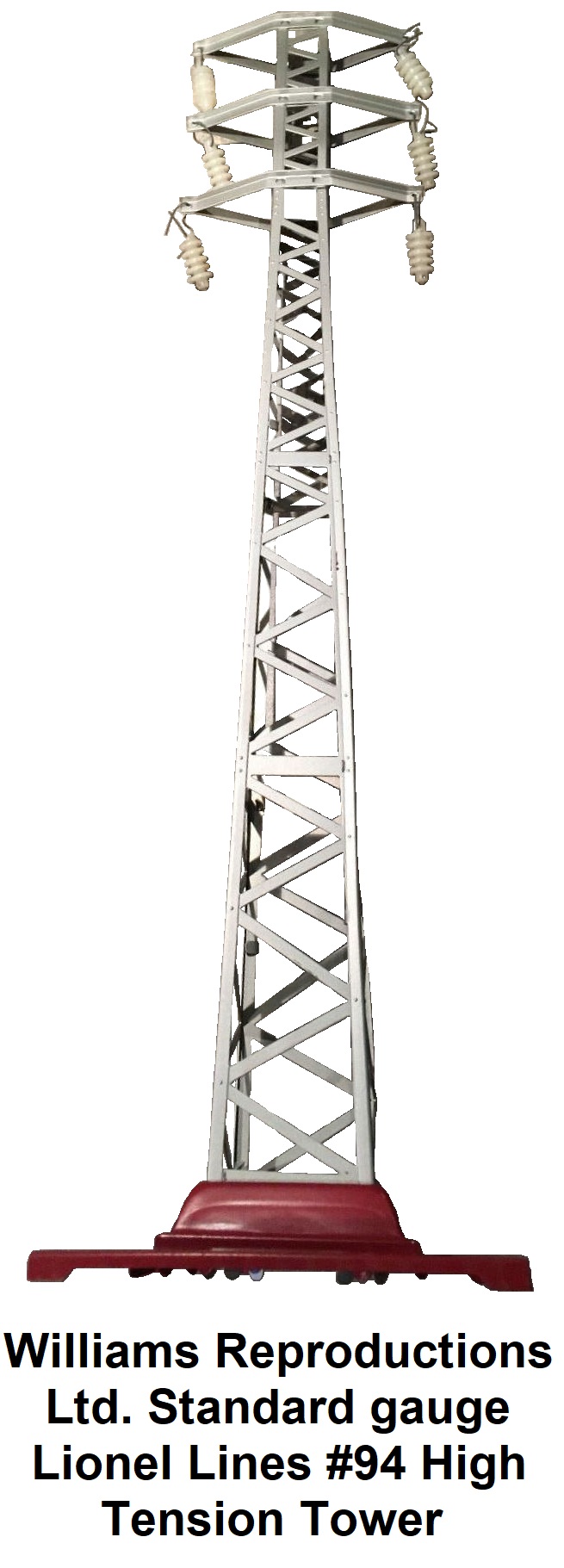 dummy units (without motors) they are sometimes mis-identified as being manufactured by McCoy, since
the maker's mark for McCoy appears on the bottom of their motor units, and those motors were frequently installed in the
Williams reproduction non-powered locos. The Williams reproductions are easily identified by the letters 'WRL' appearing on
the wheels of the unpowered units or stamped on the larger metal parts. Wheels for the #9's were supplied by both McCoy and by
Model Engineering Works. These wheels are not interchangeable, and required their own axles.
dummy units (without motors) they are sometimes mis-identified as being manufactured by McCoy, since
the maker's mark for McCoy appears on the bottom of their motor units, and those motors were frequently installed in the
Williams reproduction non-powered locos. The Williams reproductions are easily identified by the letters 'WRL' appearing on
the wheels of the unpowered units or stamped on the larger metal parts. Wheels for the #9's were supplied by both McCoy and by
Model Engineering Works. These wheels are not interchangeable, and required their own axles.
With the success of the #9 locomotive, Jerry Williams knew he had found a market for quality reproductions.
He then decided what his next project would be. Williams would begin fabrication of a reproduction
version of one of the most desirable Standard gauge electric locomotives ever made, and originally catalogued by Lionel trains
from 1928 to 1936, the #381E. However, the preparation needed for gearing up the tooling and dies would take some time to
complete. Jerry wanted to maintain product momentum and wanted to produce an offering in the interim that had a short lead
time. In 1974 Williams Reproductions released a Lionel #94 High Tension Electric Transmission Tower accessory. There was some
risk involved as Jerry knew that reproduction trains would sell but he did not know if a reproduction accessory could do well.
Initial production was limited as the towers started out as slow sellers. But interest picked up, and all of the 500 units
produced eventually sold. The towers were reproduced in red and silver colors with nylon insulators (the original Lionel
towers had ceramic insulators). All towers were offered for sale completely assembled. This time Jerry used a tower from his
own collection as the necessary model for creating the parts. A second production run was made in 1981.
The #381E locomotive turned out to be a key product for Williams. Tooling costs required a higher
selling price and on the basis of strong apparent demand, production numbers were doubled. It was offered as a non-powered
dummy unit, ready for a 'Bild-A-Loco' or 'Super' motor to be installed. The company also offered a
replacement 'Super' electric motor for sale. There were three separate production runs of the #381E locomotive - first in
1973, then another in 1976, and a final run in 1980. Around 500 of the Williams #381E's were adorned with the typical Lionel
nameplate. However, in 1976 Lionel requested that Williams no longer use their branding, and the remainder of the #381E's
(roughly 400) were badged with a 'Chicago, Milwaukee, St. Paul & Pacific' set of plates. The same set of suppliers were used
to produce the parts for the #381E, however, many new parts were needed which required 32 new dies. There were no significant
structural differences between the original Lionel #381E and the Williams reproductions. The Williams version was not
soldered however, and the larger parts were stamped 'WRL'. The first 300 units were sold with wooden display stands. All 900
locomotives were sold fully assembled, but with most trim parts to be added by the purchaser.
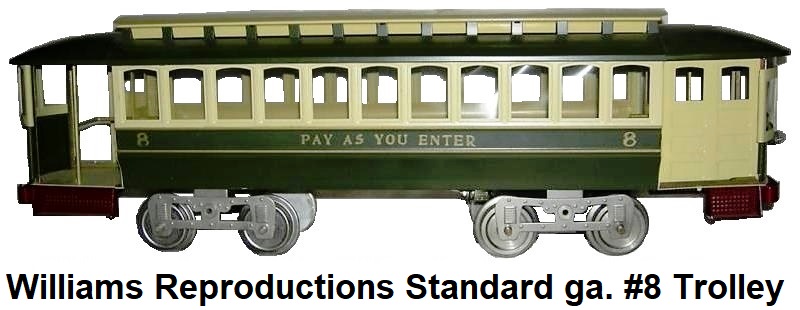 In 1975 a reproduction Lionel Standard gauge #8 'Pay As You Enter' trolley (originally catalogued by Lionel from 1910 to 1915)
with power truck and operating headlight was released. This was the largest trolley that Lionel had ever manufactured.
Williams produced 200 and they were first offered for sale at the TCA Convention. The Lionel originals were soldered
together, but the reproductions were assembled by tabs and slots that were carefully positioned
to be inconspicuous. The #8 came in an attractive redwood box, without the usual display track. All #8's were painted in
olive green and cream colors. Jerry Williams also produced a Standard gauge reproduction Lionel #2 Electric Rapid
Transit 6-window Trolley originally offered from 1914-16. To power his trolleys, Jerry Williams developed his own Standard
gauge under floor power truck, which was a self-contained unit employing a small DC can motor and chain drive mechanism using
sprocket gears to drive the wheels. The power unit wheel-set also had its own roller pick-up to collect electricity and drive
the motor. The DC motor was connected through 2 diodes to permit reversing and AC operation. These self-contained power units
became very popular with custom builders of Standard gauge motive units that lacked the space to house a full sized electric
motor in the shells.
In 1975 a reproduction Lionel Standard gauge #8 'Pay As You Enter' trolley (originally catalogued by Lionel from 1910 to 1915)
with power truck and operating headlight was released. This was the largest trolley that Lionel had ever manufactured.
Williams produced 200 and they were first offered for sale at the TCA Convention. The Lionel originals were soldered
together, but the reproductions were assembled by tabs and slots that were carefully positioned
to be inconspicuous. The #8 came in an attractive redwood box, without the usual display track. All #8's were painted in
olive green and cream colors. Jerry Williams also produced a Standard gauge reproduction Lionel #2 Electric Rapid
Transit 6-window Trolley originally offered from 1914-16. To power his trolleys, Jerry Williams developed his own Standard
gauge under floor power truck, which was a self-contained unit employing a small DC can motor and chain drive mechanism using
sprocket gears to drive the wheels. The power unit wheel-set also had its own roller pick-up to collect electricity and drive
the motor. The DC motor was connected through 2 diodes to permit reversing and AC operation. These self-contained power units
became very popular with custom builders of Standard gauge motive units that lacked the space to house a full sized electric
motor in the shells.
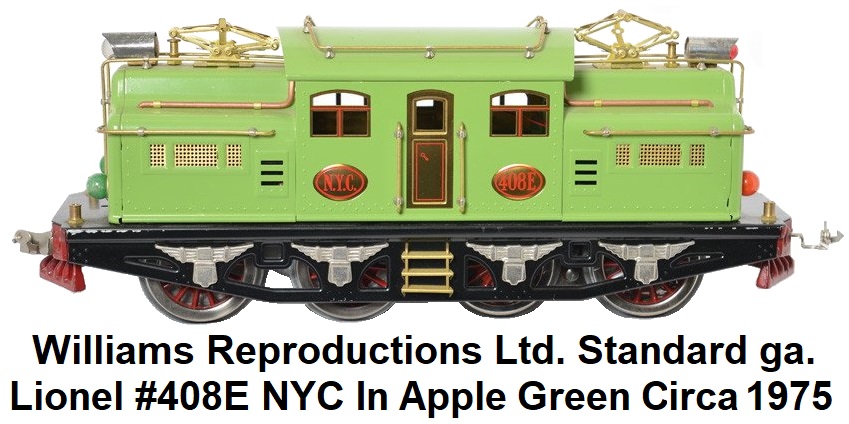
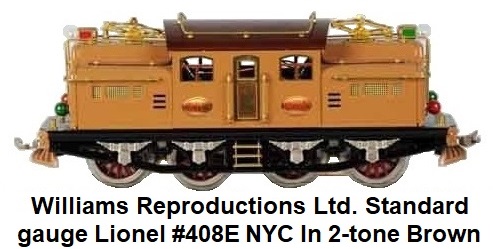
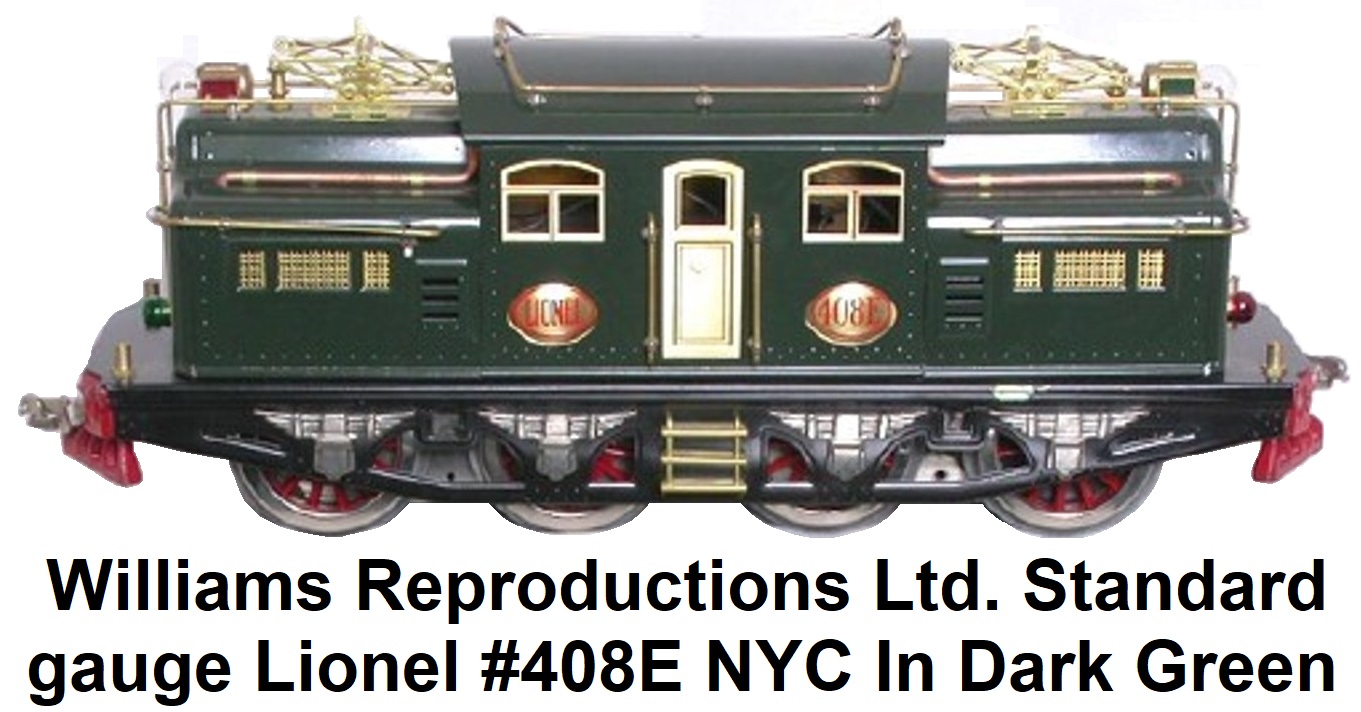
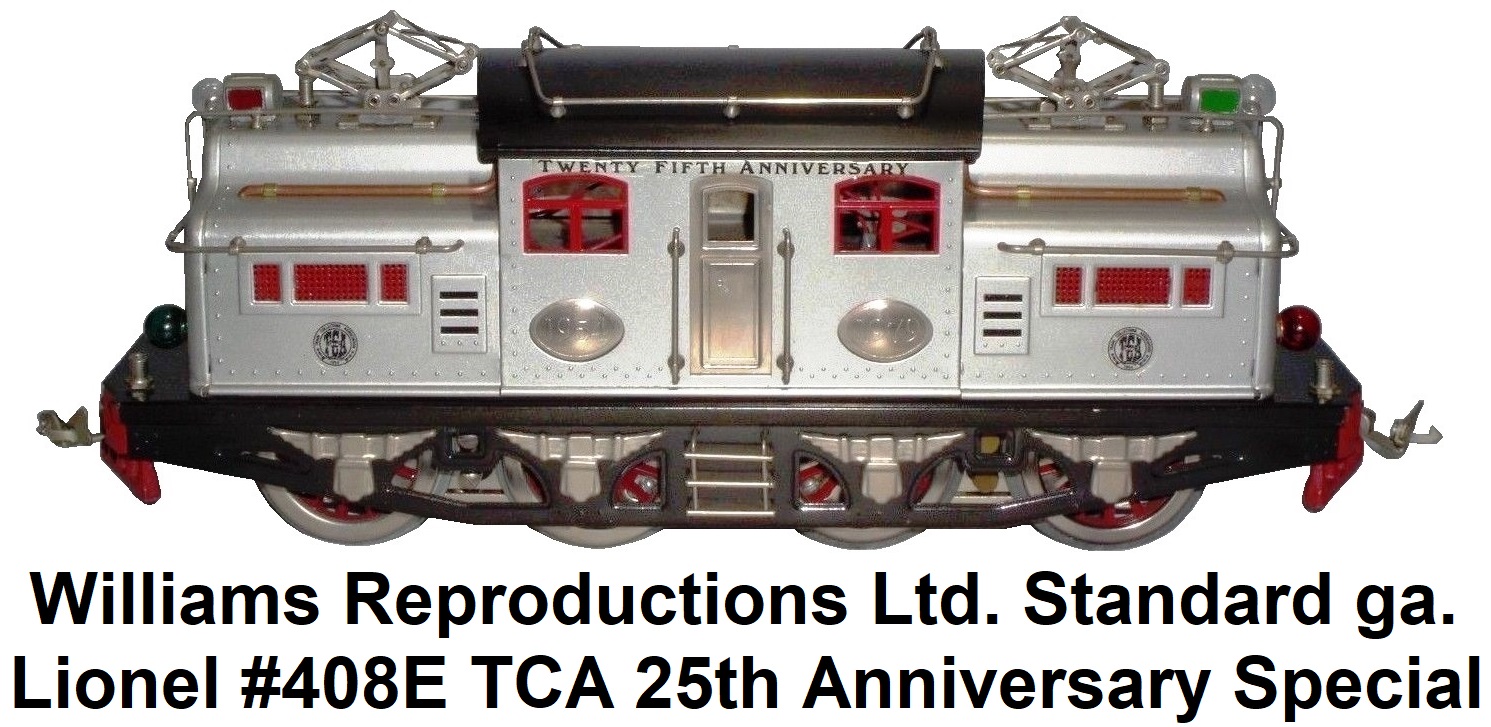
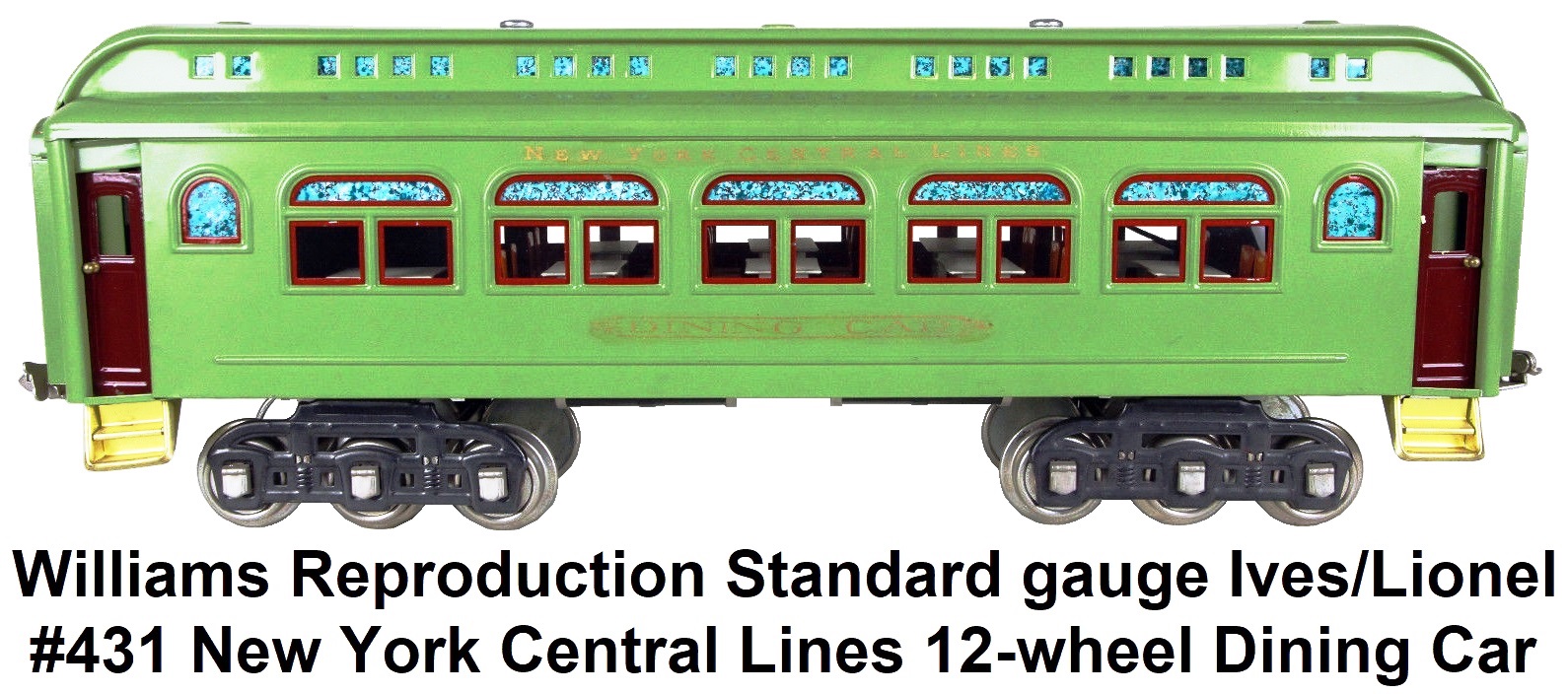
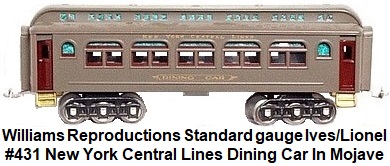 In fall 1975 Williams released a Lionel #408E 8-wheeled electric locomotive (originally catalogued by Lionel as a
dual-motored, top of the line engine starting from 1927 up until 1936, when all Standard gauge production was ceased).
300 units were produced with 75 painted in apple green, 75 in 2-tone brown, 75 in Mojave, and 75 in dark green and unpainted
kits. All #408E's were adorned with NYC nameplates and could accept either style of Standard gauge motors.
In 1978 came the matching #400 series passenger cars in 4 or 6 wheel truck versions. Offerings included the
#418 Pullman, #419 combine, #428 Pullman, #429 Pullman, #430 observation, #431 diner, and #490 observation. These cars
featured removable roofs, interior lighting, hinged doors, detailed interiors and colored transparencies in the window
transoms. The observation car had a rear platform with a dome light. 300 sets were offered in either orange, dark green,
apple green, or Mojave. Another 100 sets were produced as unpainted kits. In celebration of the TCA's 25th anniversary,
Williams released a special 3 car set headed by a #408E in silver paint. The included cars were named after the famous
manufacturers - with a Harry C. Ives combo car, a J. Lionel Cowan parlor car, and an A.C. Gilbert observation car. A Louis
Marx diner car was also made available for this set as an add-on.
In fall 1975 Williams released a Lionel #408E 8-wheeled electric locomotive (originally catalogued by Lionel as a
dual-motored, top of the line engine starting from 1927 up until 1936, when all Standard gauge production was ceased).
300 units were produced with 75 painted in apple green, 75 in 2-tone brown, 75 in Mojave, and 75 in dark green and unpainted
kits. All #408E's were adorned with NYC nameplates and could accept either style of Standard gauge motors.
In 1978 came the matching #400 series passenger cars in 4 or 6 wheel truck versions. Offerings included the
#418 Pullman, #419 combine, #428 Pullman, #429 Pullman, #430 observation, #431 diner, and #490 observation. These cars
featured removable roofs, interior lighting, hinged doors, detailed interiors and colored transparencies in the window
transoms. The observation car had a rear platform with a dome light. 300 sets were offered in either orange, dark green,
apple green, or Mojave. Another 100 sets were produced as unpainted kits. In celebration of the TCA's 25th anniversary,
Williams released a special 3 car set headed by a #408E in silver paint. The included cars were named after the famous
manufacturers - with a Harry C. Ives combo car, a J. Lionel Cowan parlor car, and an A.C. Gilbert observation car. A Louis
Marx diner car was also made available for this set as an add-on.
Williams Reproductions Ltd. Standard gauge Lionel State Set Cars In 2-tone Green
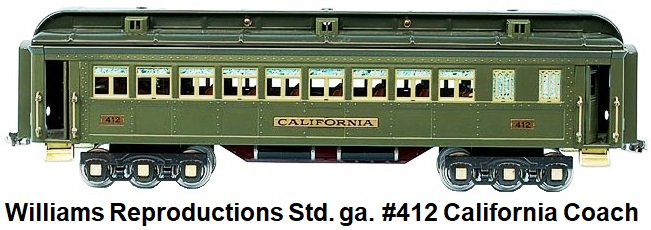
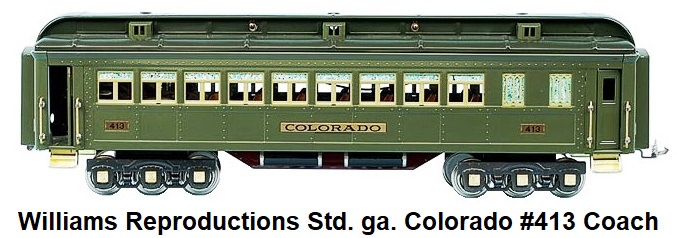
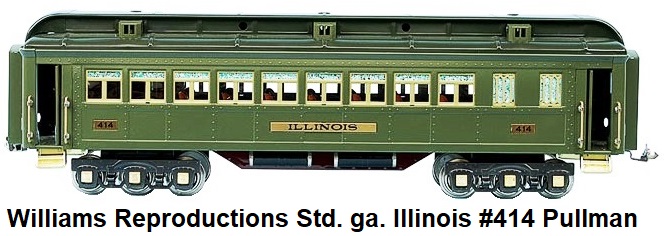

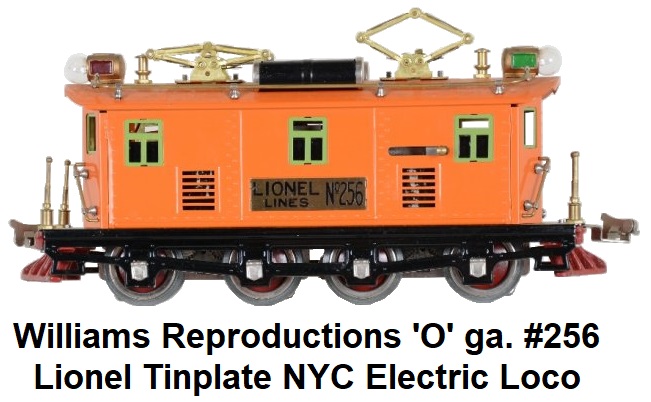 In 1980 Williams released their much longer Standard gauge tinplate reproduction Lionel state car sets with 6-wheel passenger
car trucks. These were available headed by either a #381E or #408E and consisted of the #412 California coach, #413 Colorado
coach, #414 Illinois coach and #416 New York observation car. These coaches were superbly finished and came complete with
hinged roofs, detailed interiors that included seats, washrooms and interior lighting. They were offered in 2-tone green or
2-tone brown. Finally in 1983, Williams released a Universal Dual Motored Power Unit. A reproduction Lionel 'O' gauge #256
locomotive with unbordered brass plates was created by Williams to satisfy demand from 'golden age' tinplate collectors. 500
units were built from brand new tooling.
In 1980 Williams released their much longer Standard gauge tinplate reproduction Lionel state car sets with 6-wheel passenger
car trucks. These were available headed by either a #381E or #408E and consisted of the #412 California coach, #413 Colorado
coach, #414 Illinois coach and #416 New York observation car. These coaches were superbly finished and came complete with
hinged roofs, detailed interiors that included seats, washrooms and interior lighting. They were offered in 2-tone green or
2-tone brown. Finally in 1983, Williams released a Universal Dual Motored Power Unit. A reproduction Lionel 'O' gauge #256
locomotive with unbordered brass plates was created by Williams to satisfy demand from 'golden age' tinplate collectors. 500
units were built from brand new tooling.

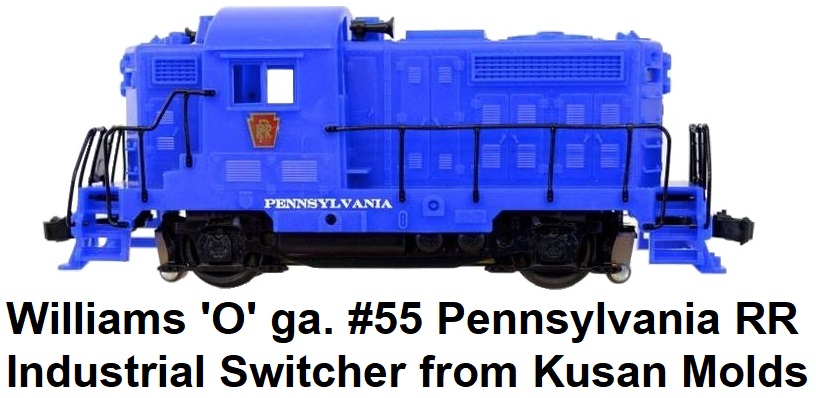
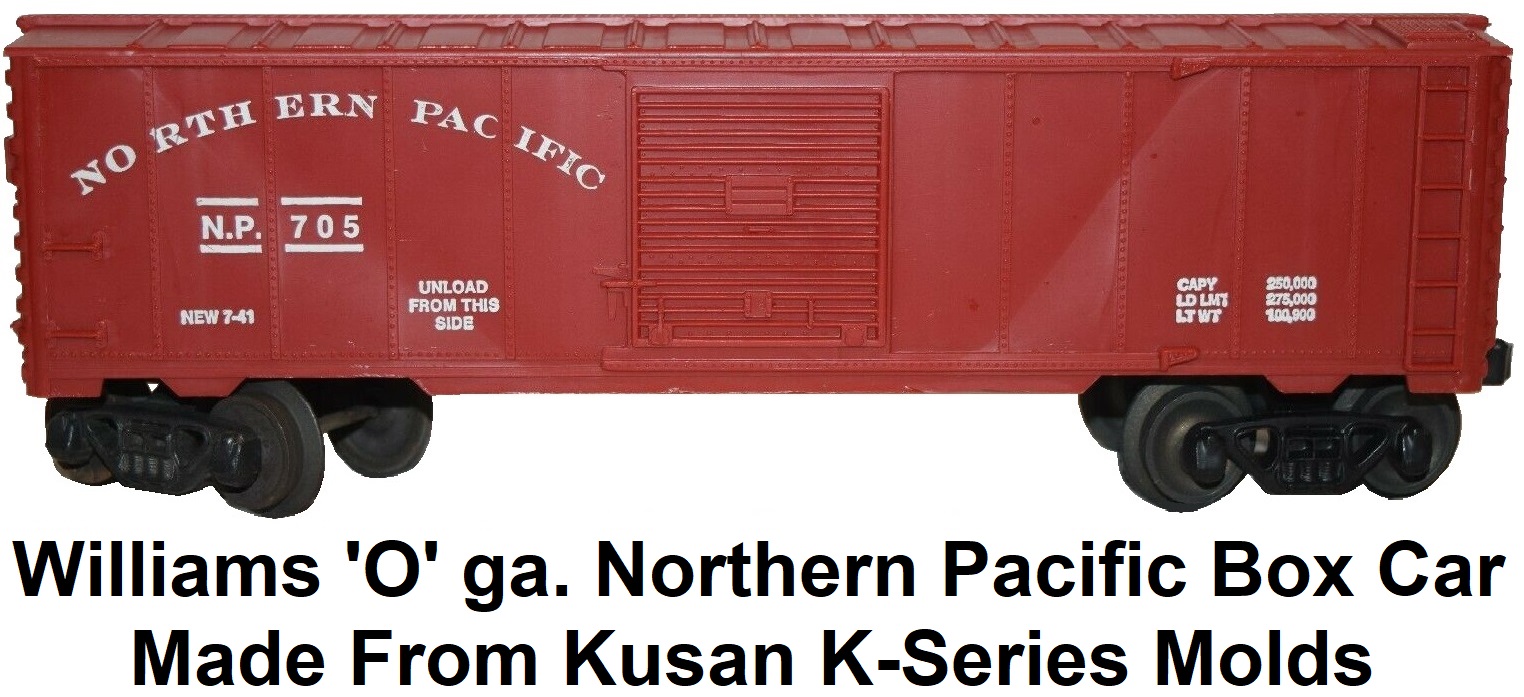 By the late 1970's Williams was slowly shifting its interest to modern 'O' gauge trains. Williams Reproductions became
Williams Electric Trains. Initial releases were a series of diesel locomotives. In an effort to add 'O' gauge freight cars to
the line, Jerry Williams initiated talks with Andy Kriswalis of Kris Model Trains, to acquire some
tooling, beginning with the purchase of much of the former Kusan Model Train's dies. The Kusan tooling
consisted of molds to manufacture 'O' gauge and smaller 'O-27' gauge trains. Williams issued plastic injection molded 'O'
gauge 40' single door box cars, plug door reefers, stock cars, gondolas, tank cars, a caboose and F unit diesels from the
Kusan molds which originally dated back to the 1950's when American Model Toys first created this
tooling. A covered cement hopper, flat car, depressed-center flat car, antenna car, cannon car, missile car, searchlight
car and an industrial type diesel switcher using original molds that Kusan developed were also produced. Kris had only
produced the box cars, gondolas, refrigerator cars, and stock cars while in possession of the former Kusan molds. Initially,
Williams offered their versions of the trains as unpainted kits without trucks, then completed ready-to-run models were
produced. The Williams finished 'O' gauge freight cars appeared almost identical to the versions of the Kris cars that were
decorated by Frank's Roundhouse including the reporting marks found on the ends of the cars and
dimensional data stamped on the box car doors. The distinguishing difference was these cars had a stamped metal underframe
with a fishbelly, and a brake cylinder mounted on the under carriage.
By the late 1970's Williams was slowly shifting its interest to modern 'O' gauge trains. Williams Reproductions became
Williams Electric Trains. Initial releases were a series of diesel locomotives. In an effort to add 'O' gauge freight cars to
the line, Jerry Williams initiated talks with Andy Kriswalis of Kris Model Trains, to acquire some
tooling, beginning with the purchase of much of the former Kusan Model Train's dies. The Kusan tooling
consisted of molds to manufacture 'O' gauge and smaller 'O-27' gauge trains. Williams issued plastic injection molded 'O'
gauge 40' single door box cars, plug door reefers, stock cars, gondolas, tank cars, a caboose and F unit diesels from the
Kusan molds which originally dated back to the 1950's when American Model Toys first created this
tooling. A covered cement hopper, flat car, depressed-center flat car, antenna car, cannon car, missile car, searchlight
car and an industrial type diesel switcher using original molds that Kusan developed were also produced. Kris had only
produced the box cars, gondolas, refrigerator cars, and stock cars while in possession of the former Kusan molds. Initially,
Williams offered their versions of the trains as unpainted kits without trucks, then completed ready-to-run models were
produced. The Williams finished 'O' gauge freight cars appeared almost identical to the versions of the Kris cars that were
decorated by Frank's Roundhouse including the reporting marks found on the ends of the cars and
dimensional data stamped on the box car doors. The distinguishing difference was these cars had a stamped metal underframe
with a fishbelly, and a brake cylinder mounted on the under carriage.
Williams Electric Trains 'O' gauge Tank Cars from AMT/Kusan Molds

Williams Electric Trains 'O' gauge 40' Box Cars from AMT/Kusan Molds
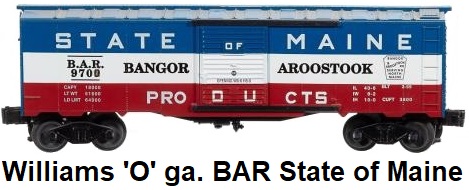
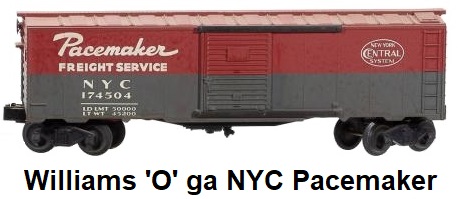
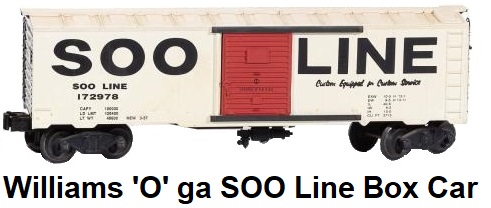

Williams Electric Trains 'O' gauge 40' Reefers Produced from AMT/Kusan Molds
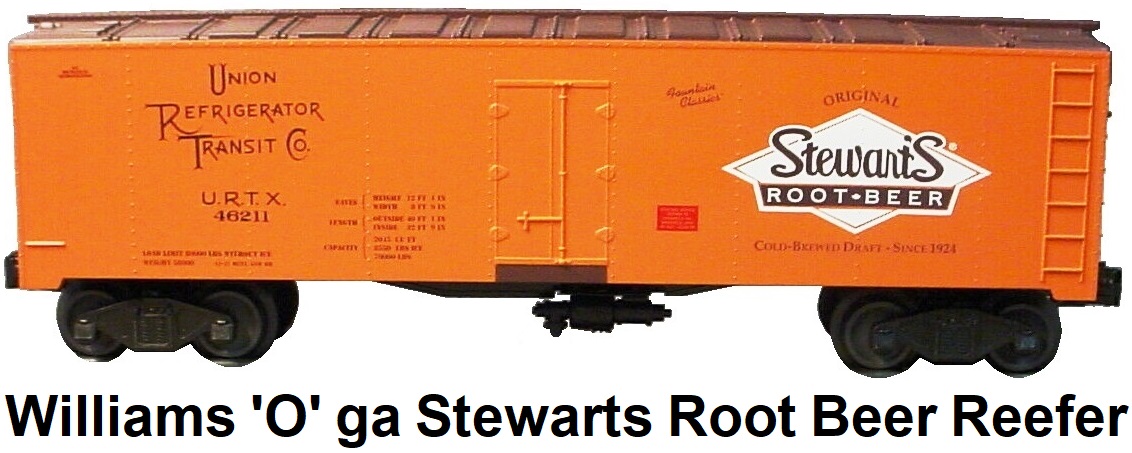
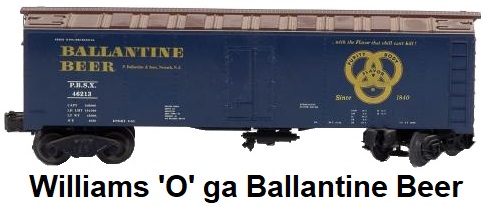
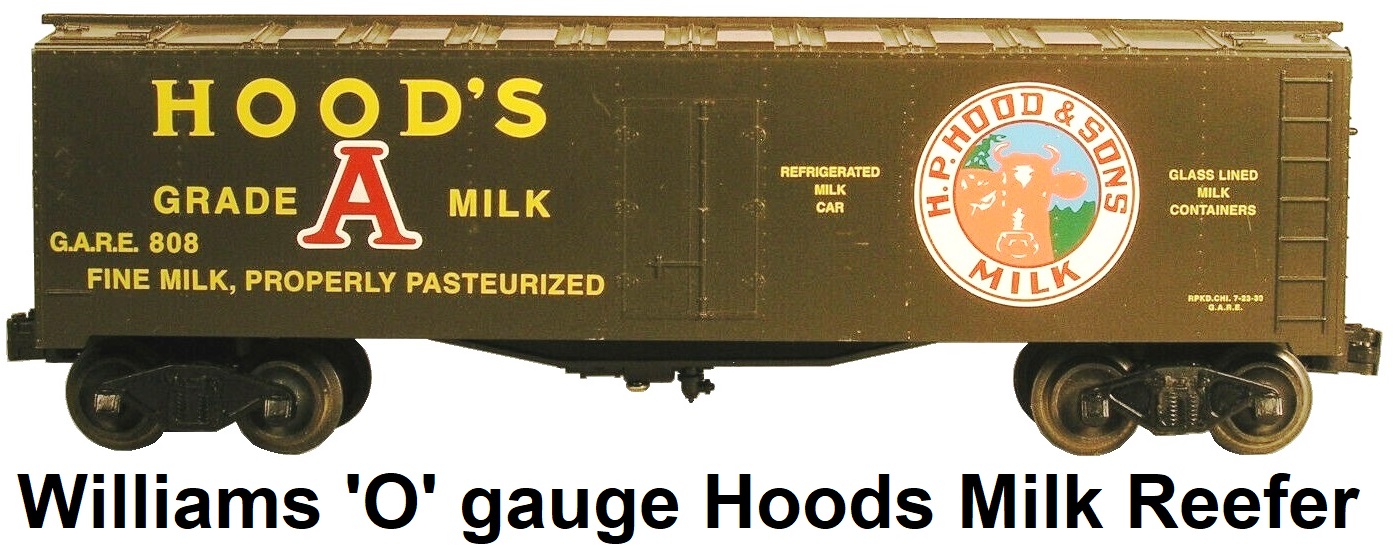
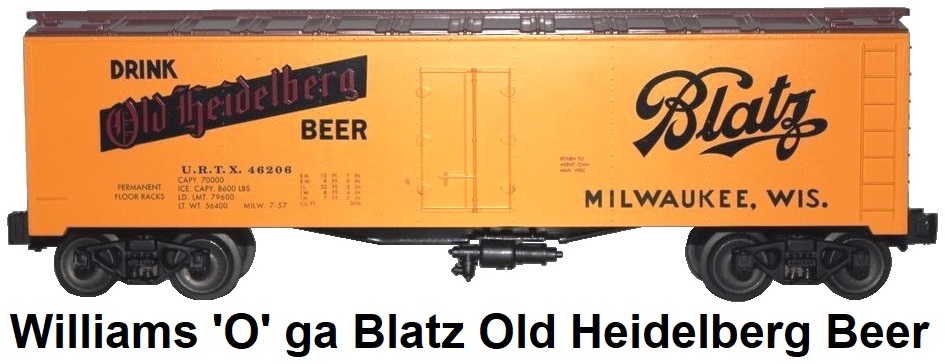
Williams Electric Trains 'O' gauge 40' Stock Cars Produced from AMT/Kusan Molds
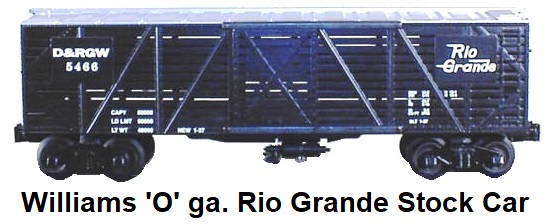
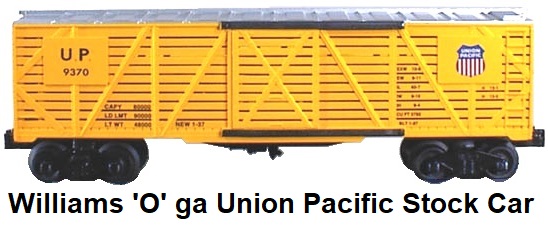
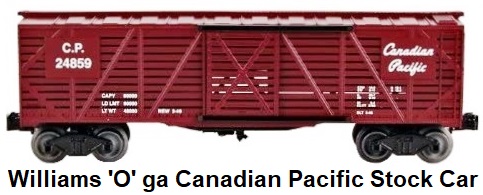
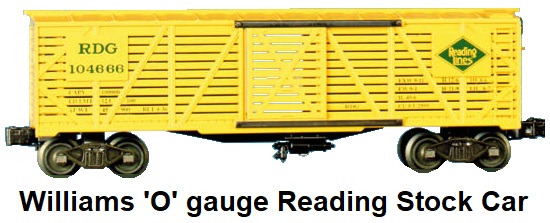
 The company eventually started making post-war era 'O' gauge Lionel replicas, starting with the classic GG-1 electric,
Madison-style heavyweight passenger cars and Fairbanks Morse Trainmaster diesel loco. This marked the beginning of the
firm's 'Golden Memory' series. Complete Williams sets were made in the mid 1970's to 1980's including NASA sets and military
sets.
The company eventually started making post-war era 'O' gauge Lionel replicas, starting with the classic GG-1 electric,
Madison-style heavyweight passenger cars and Fairbanks Morse Trainmaster diesel loco. This marked the beginning of the
firm's 'Golden Memory' series. Complete Williams sets were made in the mid 1970's to 1980's including NASA sets and military
sets.
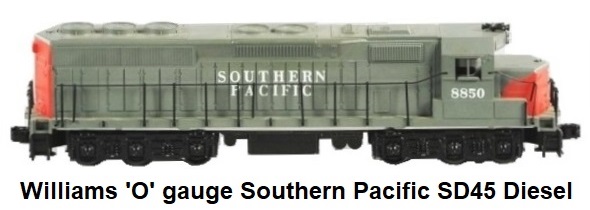 The Williams Electric Trains F-7 diesel produced from the Kusan molds was powered by the same Mabuchi motor
that was fitted into the FM Trainmaster. A new, lowered floor was required to house this taller DC can-type electric motor.
Williams developed its own power truck and side frames. The same can motor was also utilized to drive the Williams SD-45
diesel and GG-1 electric locos. Towards the end of 1985 Williams sold a large portion of the Kusan tooling and molds that it
was not using to K-line Electric Trains of Chapel Hill, NC, that was founded and operated by Maury
D. Klein. Williams only retained the F-7 diesel tooling and the larger 'O' gauge freight car molds.
The Williams Electric Trains F-7 diesel produced from the Kusan molds was powered by the same Mabuchi motor
that was fitted into the FM Trainmaster. A new, lowered floor was required to house this taller DC can-type electric motor.
Williams developed its own power truck and side frames. The same can motor was also utilized to drive the Williams SD-45
diesel and GG-1 electric locos. Towards the end of 1985 Williams sold a large portion of the Kusan tooling and molds that it
was not using to K-line Electric Trains of Chapel Hill, NC, that was founded and operated by Maury
D. Klein. Williams only retained the F-7 diesel tooling and the larger 'O' gauge freight car molds.

Williams was the first manufacturer to produce an 'O' gauge model of the General Electric E60 electric
locomotive, starting in 1977. The E60 was originally offered only as a plastic molded body kit, with a stamped steel floor
designed to receive Lionel MPC era trucks, E-units and Pullmore motors. In 1981 the E60 was made in a dual can-motored version
mounted on a Williams Trainmaster chassis. A 3rd version was single motored. Over its lifespan, the E60 appeared in several
road names, including Amtrak (silver, red, white and blue), Burlington Northern (black and cascade green), Conrail (blue and
white), New Haven (black, white and orange), Penn Central (black and white), Pennsylvania (Tuscan) and the Virginian (blue and
yellow). Early models featured incorrect 4-axle trucks, but the later versions bore the more prototypical 6-axle trucks.
Williams utilized a 6-axle truck that was developed for an E-7 locomotive. The significance of the GE E60 locomotive in the
Williams line is that it was the first original body style specifically designed by Williams.
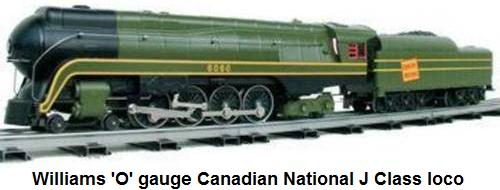 During the 1980's the demand for scale sized locomotives increased dramatically.
In response to this demand, Williams created its Crown Edition Line. These models were nicely detailed
handmade brass scale models produced as limited-editions. They started out as very simple models of common steam locomotives.
Production mostly took place through Samhongsa, a sub-contractor in Seoul, South Korea. Later releases were models built for
the first time in 3-rail 'O' gauge including The Pennsylvania RR K-4 4-6-2 (1986-87), NYC Niagara 4-8-4 (1990), Norfolk &
Western J-Class 611 bulletnose 4-8-4 (1990), Union Pacific Big Boy 4-8-8-4 (1989 and 1995), a 4-6-0 Camelback Loco (1990),
and the Southern Pacific Cab Forward 4-8-8-2 (1990). Thus Williams became a major distributor for
scale-like three rail locomotives and cars. This was the birth of 'Hi-Rail' or scale sized items for 3-rail track.
During the 1980's the demand for scale sized locomotives increased dramatically.
In response to this demand, Williams created its Crown Edition Line. These models were nicely detailed
handmade brass scale models produced as limited-editions. They started out as very simple models of common steam locomotives.
Production mostly took place through Samhongsa, a sub-contractor in Seoul, South Korea. Later releases were models built for
the first time in 3-rail 'O' gauge including The Pennsylvania RR K-4 4-6-2 (1986-87), NYC Niagara 4-8-4 (1990), Norfolk &
Western J-Class 611 bulletnose 4-8-4 (1990), Union Pacific Big Boy 4-8-8-4 (1989 and 1995), a 4-6-0 Camelback Loco (1990),
and the Southern Pacific Cab Forward 4-8-8-2 (1990). Thus Williams became a major distributor for
scale-like three rail locomotives and cars. This was the birth of 'Hi-Rail' or scale sized items for 3-rail track.



At the same time, Williams was phasing out, and eventually discontinued its tinplate Standard gauge
offerings, selling the tooling to the company that later became MTH Electric Trains in 1982.
Interestingly, Mike Wolf, the founder of MTH, had begun working for Jerry Williams at Williams Reproductions Limited in 1973
as a 12 year old kid. Mike lived in the same Howard County Maryland neighborhood as Jerry. Mike and several of his
schoolmates were employed to assemble latch couplers and other parts for the pre-war era reproduction trains in Jerry's
basement. Mike Wolf continued to work for Jerry throughout his high school and college years, until 1980, when Mike's Train
House was started.
 Other brass 'O' scale locomotives produced by Williams Electric Trains included the B&O 4-6-2 Pacific (1984), NYC J3a
4-6-4 Hudson (1984 and 1995), NYC Dreyfuss Hudson (1984 and 1995), Baldwin Shark Nose diesel (1985), Pennsy L1 2-8-2 (1987),
PRR B6 0-6-0 (1987), UP Challenger 4-6-6-4 (1987-88 and 1995), a modern K4 4-6-2 (1989), a USRA 4-6-2 in 7 road names (1989),
Southern Ps-4 4-6-2 (1989), Pennsy 4-4-2 (1989), SP GS4 4-8-4 (1989), a USRA 2-8-2 in five road names (1990), PRR S2 Turbine
(1991), PRR 4-4-4-4 in several paint variations (1992), and a Streamlined Pennsy K4 (1995).
Other brass 'O' scale locomotives produced by Williams Electric Trains included the B&O 4-6-2 Pacific (1984), NYC J3a
4-6-4 Hudson (1984 and 1995), NYC Dreyfuss Hudson (1984 and 1995), Baldwin Shark Nose diesel (1985), Pennsy L1 2-8-2 (1987),
PRR B6 0-6-0 (1987), UP Challenger 4-6-6-4 (1987-88 and 1995), a modern K4 4-6-2 (1989), a USRA 4-6-2 in 7 road names (1989),
Southern Ps-4 4-6-2 (1989), Pennsy 4-4-2 (1989), SP GS4 4-8-4 (1989), a USRA 2-8-2 in five road names (1990), PRR S2 Turbine
(1991), PRR 4-4-4-4 in several paint variations (1992), and a Streamlined Pennsy K4 (1995).

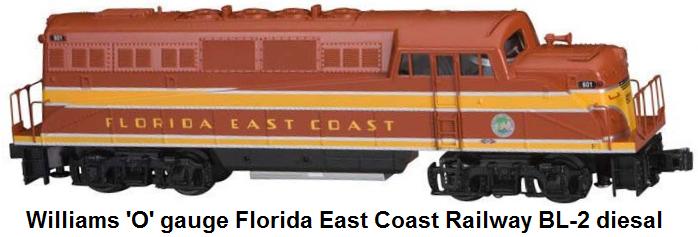 As the 1980's came to an end and the US economy went into a recession, the demand for expensive scale
models declined, and Williams focused on more economical-to-produce diesel models such as F-3's, Geep's and SW1
switchers. From 1990 to 2007, Jerry concentrated on the development of models of diesels, passenger cars and rolling
stock and the expansion of the Golden Memories line. In 2000, he indulged himself by making one of his favorite models,
the Lionel #671 turbine locomotive first cataloged in the mid-1940’s. Most people discouraged him from making this model
since they were common items, but Jerry’s instinct was right again and this model proved to be a success. The Williams
S-2 Turbine #671 6-8-6 in 'O' gauge was similar in appearance to the Lionel post-war era model in dimensions and die-cast
materials, but featured a can electric motor with a flywheel coasting action, a Seuthe smoke unit, rubber traction tires, an
electronic reversing mechanism, True Blast II Digital Whistle & Bell, a constant voltage operating headlight, and
steel rimmed drivers.
As the 1980's came to an end and the US economy went into a recession, the demand for expensive scale
models declined, and Williams focused on more economical-to-produce diesel models such as F-3's, Geep's and SW1
switchers. From 1990 to 2007, Jerry concentrated on the development of models of diesels, passenger cars and rolling
stock and the expansion of the Golden Memories line. In 2000, he indulged himself by making one of his favorite models,
the Lionel #671 turbine locomotive first cataloged in the mid-1940’s. Most people discouraged him from making this model
since they were common items, but Jerry’s instinct was right again and this model proved to be a success. The Williams
S-2 Turbine #671 6-8-6 in 'O' gauge was similar in appearance to the Lionel post-war era model in dimensions and die-cast
materials, but featured a can electric motor with a flywheel coasting action, a Seuthe smoke unit, rubber traction tires, an
electronic reversing mechanism, True Blast II Digital Whistle & Bell, a constant voltage operating headlight, and
steel rimmed drivers.

 Although Williams was often considered a maker of reproduction 1950's-era Lionel equipment,
Williams' offerings are distinguishable from the Lionel originals because Williams sometimes added details
that were not possible using 1950's manufacturing methods. The Williams 'O' gauge model of the EP-5 electric
was fitted with 6-wheel trucks, just like the prototype, while Lionel's EP-5 sported 4-wheel non-prototypical trucks.
The early post-war era Lionel FA-2 Alco type diesels issued in Union Pacific, Erie and Rock Island paint schemes featured
die-cast frames with the gas tanks molded in, die-cast pilots, electronic coil-type operating knuckle couplers and illuminated
marker lights bearing the loco number. By 1957, Lionel had greatly cheapened these Alco loco models, replacing the heavy
die-cast frames with lightweight stamped steel frames, replaced the lighted number boards with blank ones, and replaced the
electronic coil couplers with either magnetic disc type couplers or non-operating plastic ones. In the last years of
production the front coupler was completely removed and the coupler pocket was filled in. The later versions were fitted with
a plastic side frame gas tank. When Williams came out with its version of the FA Alcos, they featured die-cast frames,
powerful motors and excellent graphics. All of the road names that Lionel had issued in both the cheapened, as well as in
the earlier versions were recreated on the higher quality Williams models. Several road names that Lionel never produced were
also created by Williams.
Although Williams was often considered a maker of reproduction 1950's-era Lionel equipment,
Williams' offerings are distinguishable from the Lionel originals because Williams sometimes added details
that were not possible using 1950's manufacturing methods. The Williams 'O' gauge model of the EP-5 electric
was fitted with 6-wheel trucks, just like the prototype, while Lionel's EP-5 sported 4-wheel non-prototypical trucks.
The early post-war era Lionel FA-2 Alco type diesels issued in Union Pacific, Erie and Rock Island paint schemes featured
die-cast frames with the gas tanks molded in, die-cast pilots, electronic coil-type operating knuckle couplers and illuminated
marker lights bearing the loco number. By 1957, Lionel had greatly cheapened these Alco loco models, replacing the heavy
die-cast frames with lightweight stamped steel frames, replaced the lighted number boards with blank ones, and replaced the
electronic coil couplers with either magnetic disc type couplers or non-operating plastic ones. In the last years of
production the front coupler was completely removed and the coupler pocket was filled in. The later versions were fitted with
a plastic side frame gas tank. When Williams came out with its version of the FA Alcos, they featured die-cast frames,
powerful motors and excellent graphics. All of the road names that Lionel had issued in both the cheapened, as well as in
the earlier versions were recreated on the higher quality Williams models. Several road names that Lionel never produced were
also created by Williams.


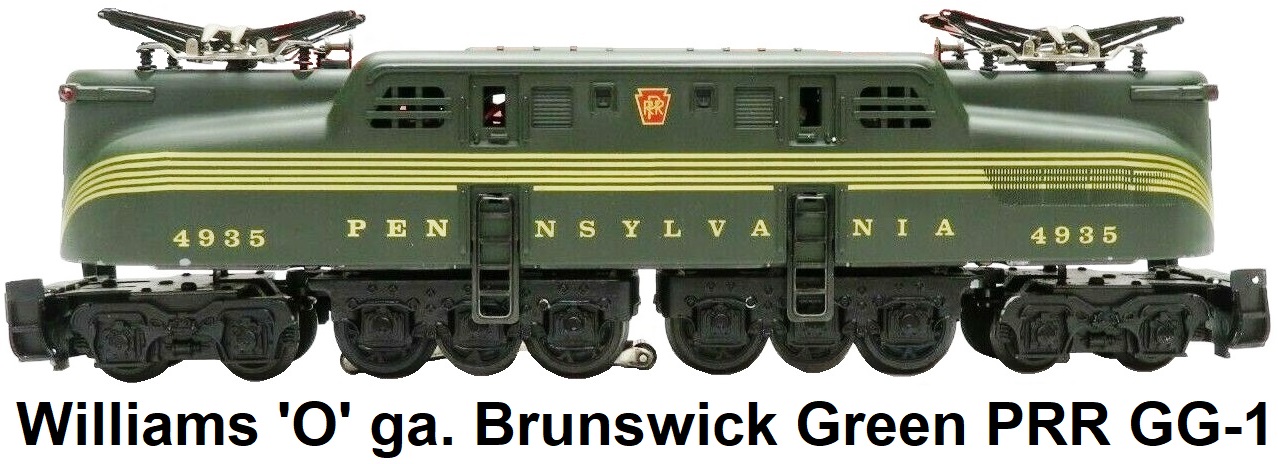 Unlike most other 'O' scale manufacturers, Williams never added electronics such as Trainmaster Command
Control (TMCC) or Digital Command System (DCS) to its locomotives. This decision gained Williams a small but devoted following
among those hobbyists who wanted a more "traditional" train layout reminiscent of the 1950's but who also wanted to buy modern
equipment at reasonable prices. Some locomotives did not even have a reversing unit. However, this decision also allowed
companies such as MTH and K-Line to eclipse Williams in size in spite of being an older company. The
Williams Crown Edition locomotives were equipped with a QSI Industries circuit board that featured electronic horn and bell
features, revving sounds in diesels, train number announcements and departure track announcement. The older Williams
locomotives that were not part of the Crown Edition line also had QSI boards, but only provided horn sounds.
Unlike most other 'O' scale manufacturers, Williams never added electronics such as Trainmaster Command
Control (TMCC) or Digital Command System (DCS) to its locomotives. This decision gained Williams a small but devoted following
among those hobbyists who wanted a more "traditional" train layout reminiscent of the 1950's but who also wanted to buy modern
equipment at reasonable prices. Some locomotives did not even have a reversing unit. However, this decision also allowed
companies such as MTH and K-Line to eclipse Williams in size in spite of being an older company. The
Williams Crown Edition locomotives were equipped with a QSI Industries circuit board that featured electronic horn and bell
features, revving sounds in diesels, train number announcements and departure track announcement. The older Williams
locomotives that were not part of the Crown Edition line also had QSI boards, but only provided horn sounds.

 The Williams 'O' gauge E-7 diesel locomotive was produced from all new tooling. Motive power for the E7 is
provided by a pair of flywheel-equipped can motors. The flywheel provides a coasting action. The locomotive featured a
sheet-metal frame and ladders and a heavy die-cast metal fuel tank. The plastic shell has skirting for the fuel tank. The
three-axle trucks and couplers are made of die-cast metal. The trucks are good representations of EMD A1A trucks (noted for
equal spacing between axles compared to non-Flexicoil EMD three-axle trucks with uneven axle spacing). It was offered in
powered and dummy A units, and a dummy B unit. The powered E7 was fitted with 2 headlights. The top fixture is a Mars or ditch
light with simulated flashing. The light turns on and off in response to the locomotive's E- unit. Even at 13 inches long
these engines will navigate O-31 track curves, but look much less awkward and more prototypical on a minumum O-54 radius track
curve. The E-7 was offered in 14 different road names.
The Williams 'O' gauge E-7 diesel locomotive was produced from all new tooling. Motive power for the E7 is
provided by a pair of flywheel-equipped can motors. The flywheel provides a coasting action. The locomotive featured a
sheet-metal frame and ladders and a heavy die-cast metal fuel tank. The plastic shell has skirting for the fuel tank. The
three-axle trucks and couplers are made of die-cast metal. The trucks are good representations of EMD A1A trucks (noted for
equal spacing between axles compared to non-Flexicoil EMD three-axle trucks with uneven axle spacing). It was offered in
powered and dummy A units, and a dummy B unit. The powered E7 was fitted with 2 headlights. The top fixture is a Mars or ditch
light with simulated flashing. The light turns on and off in response to the locomotive's E- unit. Even at 13 inches long
these engines will navigate O-31 track curves, but look much less awkward and more prototypical on a minumum O-54 radius track
curve. The E-7 was offered in 14 different road names.
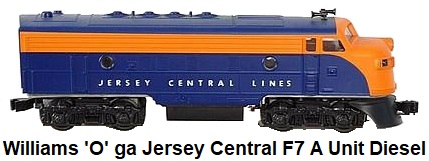 After 35 years, Jerry Williams decided to retire from the model railroad business.
In October 2007, Williams was acquired by Bachmann Industries. Bachmann continued to produce a
Williams line of 3-rail 'O' gauge trains, track and accessories. In 2016 Jerry Williams was inducted into the Hobby
Manufacturers Association Hall of Fame. Jerry’s vision and competition forced other companies to raise their standards.
Additionally, many of today’s train manufacturers have benefited from the experience that they learned while working with
Jerry. These include Mike Wolf and Andy Edleman of MTH, Ken Silvestri of Broadway Limited, and Larry Harrington of Bachmann
Industries. On November 1, 2016, Jerome (Jerry) M. Williams, founder of Williams Reproductions and a pioneer
in creating product for the 3-rail 'hi-rail' market, passed away.
After 35 years, Jerry Williams decided to retire from the model railroad business.
In October 2007, Williams was acquired by Bachmann Industries. Bachmann continued to produce a
Williams line of 3-rail 'O' gauge trains, track and accessories. In 2016 Jerry Williams was inducted into the Hobby
Manufacturers Association Hall of Fame. Jerry’s vision and competition forced other companies to raise their standards.
Additionally, many of today’s train manufacturers have benefited from the experience that they learned while working with
Jerry. These include Mike Wolf and Andy Edleman of MTH, Ken Silvestri of Broadway Limited, and Larry Harrington of Bachmann
Industries. On November 1, 2016, Jerome (Jerry) M. Williams, founder of Williams Reproductions and a pioneer
in creating product for the 3-rail 'hi-rail' market, passed away.
Link to Williams Trains
by Bachmann Web Site.
Back To Top of Page

